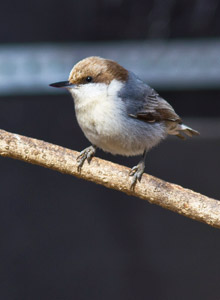
The Brown-headed Nuthatch lives only in the southeastern United States. It is a year-round resident of North Carolina and is often seen in winter at suet feeders and sunflower seed feeders in neighborhoods that have pine trees. Its favorite food is pine seeds and many insects in mature pine forests, its natural habitat. These birds usually forage high up in the pines. Primary competition for this food resource is the Pine Warbler and these two species will attack one another in their bids to obtain food. Brown-headed Nuthatches have been able to adapt to suburban landscapes that still contain pine trees as long as there are older trees and preferably snags that the birds can excavate for nesting. Its squeaky toy voice is easily recognized and seems appropriate for this small, just under 4 inch long bird.
Nest-building usually begins in February and the nest cavity is lined with grasses, inner wood chips and other material. Nest cavities can be at any height, but are usually surprisingly low –around 5 feet from the ground is not uncommon. Usually 5 or 6 eggs are laid and incubation takes two weeks. Young birds leave the nest after 18 or 19 days. Often, the parents will be aided in feeding the nestlings by young males from the prior year’s brood. Brown-headed Nuthatches use pieces of bark to pry open crevices where insects are located. These birds also store food in pine bark crevices.
The Brown-headed Nuthatch’s conservation status is of some concern due to loss of mature pines, especially pine snags, which they need for their cavity nests. For this reason, Wake Audubon, along with the other North Carolina Audubon chapters, is promoting the placement of Brown-headed Nuthatch nesting boxes. The birds will readily use such boxes. The boxes can be places in the same area as Eastern Bluebird boxes, as long as they are at least 15 feet apart. The nuthatch boxes have a 1 inch diameter hole, while the bluebird boxes have a 1 1/2 inch diameter hole. The nuthatch boxes may also be used by chickadees, but most other local cavity nesting birds are too large to enter these boxes.
Buy a nest box from Wake Audubon ($15 at any of our monthly meetings) or at a local wild bird store. You can also modify a bluebird nest box by attaching an “excluder” that makes the hole smaller.
Become a citizen scientist and register your nest box with Audubon NC to help us track the number of houses going up – and who nests inside. Learn more about the statewide Brown-headed Nuthatch and Bird Friendly Communitiesinitiatives on the Audubon NC web site.
